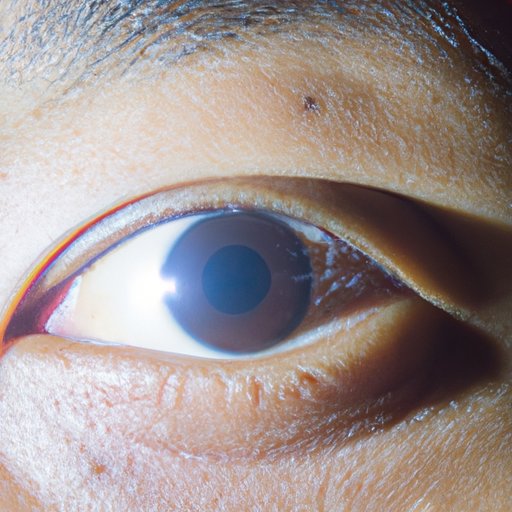
Introduction
A tumor behind the eye is a type of eye cancer that originates from the cells of the eye or the surrounding tissues. This type of cancer can affect people of any age, and, if left untreated, can cause permanent vision loss or, in severe cases, lead to life-threatening complications. Thus, it is essential to recognize the early warning signs of a tumor behind the eye to seek prompt medical help. In this article, we will discuss the symptoms of a tumor behind the eye, detection, and the available treatment options.
Signs and Symptoms of a Tumor behind the Eye: Know the Early Warning Signs
Early detection is the key to successful treatment of a tumor behind the eye. Some common symptoms include:
- Vision changes, such as blurring or distortion of images, or even total loss of vision
- Eye pain or pressure, which may be severe and persistent
- Bulging of the eye, especially if sudden or painful
- Double vision, which may occur when looking in certain directions or may worsen over time
Symptoms may vary depending on the location and size of the tumor. For example, if the tumor is located near the optic nerve, a person may experience vision loss or changes. If the tumor is pressing on surrounding tissues, the eye may bulge outwards or feel painful. It is important to recognize early warning signs and seek medical help promptly.
Tumor Behind the Eye: How to Spot the Symptoms and Seek Medical Help
If you experience any of the symptoms mentioned above, it is essential to seek medical help promptly with a medical professional, such as an ophthalmologist or an eye specialist. During your medical evaluation, the following tests may be performed:
- Eye examination and a visual field test
- Ultrasound or MRI imaging of the eye and surrounding tissues
- Biopsy, in which a small tissue sample is taken for testing under a microscope
It is important to work with a medical team and stay informed throughout the treatment process. Your doctor may also recommend additional tests to determine the extent of the tumor and create a treatment plan.
Understanding the Symptoms of an Eye Tumor: How to Detect Early Warning Signs
Early detection is critical for the best possible outcomes. Some individuals may be at higher risk of developing a tumor behind the eye, including those with a family history of eye cancer or certain medical conditions, such as neurofibromatosis or retinoblastoma. It is essential to discuss potential individual risks and screening options with a medical professional. Some screening and monitoring options may include:
- Regular eye exams and routine screening tests
- Imaging studies such as MRI or CT scans
If you or a loved one are at higher risk for developing a tumor behind the eye, it is important to discuss this with a medical professional regularly.
Explaining the Symptoms of an Eye Tumor: What People often Misinterpret
Many symptoms of a tumor behind the eye may be mistaken for other eye-related conditions. For example, vision changes may be attributed to aging or refractive errors, while eye pain or pressure may be misinterpreted as eye strain or sinus issues. If any concerning symptoms arise, it is important to seek medical help promptly.
Unraveling the Mysteries of Eye Tumors: Symptoms, Treatment, and Prognosis
The treatment approach and prognosis may vary depending on the type and size of the tumor. Treatment options may include:
- Radiation therapy, in which high-energy x-rays or other types of radiation are used to kill cancer cells
- Chemotherapy, in which drugs are used to kill cancer cells
- Surgery to remove the tumor, which may be the first treatment option for smaller tumors
The potential impact on vision and quality of life, as well as the importance of emotional and psychological support, should also be considered when developing a treatment plan.
Eye Tumors: What’s Behind the Symptoms
The causes of a tumor behind the eye are not yet fully understood, although some risk factors have been identified, including genetics, age, and previous eye injuries or surgeries. Ongoing research is necessary to better understand the development and progression of eye tumors.
Resources are available for individuals and families affected by a tumor behind the eye, including advocacy groups, support groups, and information centers. It is important to seek out these resources and engage with a medical team to develop the best treatment plan.
Conclusion
A tumor behind the eye can have serious consequences, but early detection and prompt medical intervention can help ensure the best possible outcomes. It is essential to recognize the symptoms of a tumor behind the eye, seek medical help promptly, and work with a medical team to develop a treatment plan that meets individual needs. With ongoing research and support, people affected by this type of cancer can access the resources they need to improve their quality of life.




